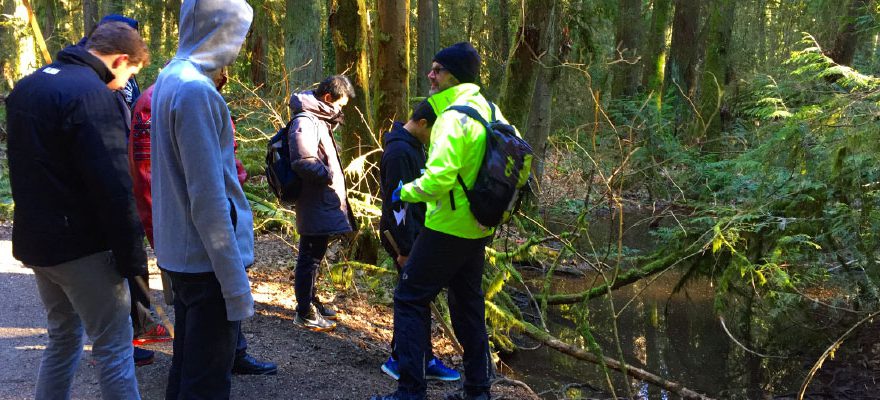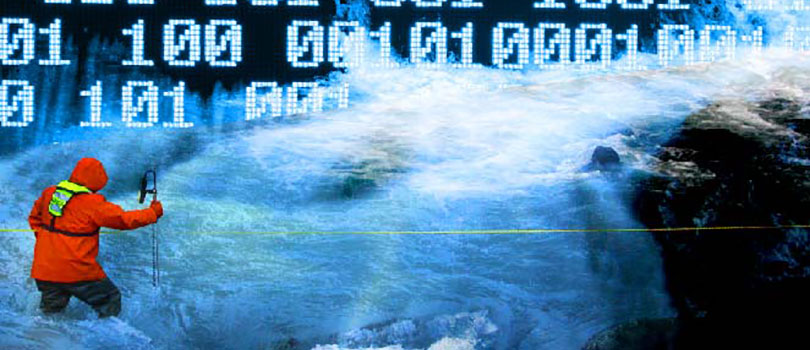
Hydrometry & Hydrology – The Next Generation
At Aquatic Informatics we are encouraged to take an active role in the community and so I was quick to agree when I was recently asked do a short course on hydrology for a conference on Global Stewardship at a local private school. It turned out to be a lot of fun, for me at least.
I took a look on a map and realized that because the school is located at the crest of a hill and on the edge of a large forested park it provided an excellent opportunity to do a comparison and contrast between forest and urban hydrology. There is a lovely stream running through the forest, which provided an excellent contrast to an adjacent stream course that has been completely built over with housing.
We started the day in the classroom reviewing some concepts that we would be talking about in the field.
I provided them with the drainage area of the forest stream that we would be visiting and had them calculate the total runoff for the month of February using climate statistics and estimates of losses from interception, evaporation, transpiration, and groundwater recharge that I provided. We discussed the assumptions implicit in our estimates and the uncertainties resulting from our assumptions.
To put the total volume of flow for February into meaningful context, we calculated the volume of the room we were in and determined how many roomfuls of water this small (1.3 km2) stream produces in a month. Our calculations showed there was enough water to fill the large classroom to the top ten times a day for the whole month. We then divided the total volume by the number of seconds in the month to obtain an estimate of the instantaneous discharge we could expect to find when we visited the creek. My hope was that the students would develop an understanding of how even a small amount of flow, per second, produces a lot of water because there are a lot of seconds in a day.
On the walk, through the forest to the stream crossing, we stopped several times to investigate the credibility of our assumptions.
Random inspections of the forest canopy validated our interception assumption. Inspection of soil moisture variability and standing water at the foot of steep hillslopes validated our assumptions about soil water processes. Puddles provided some evidence about the rate of evaporation since the last rainfall event.
When we got to the stream we conducted a discharge measurement using meter sticks, a tape measure, floats (we used coloured ice cubes as floats), and a stop watch. We calculated the streamflow and estimated the uncertainty in our measurements. The uncertainty in our prediction of instantaneous discharge overlapped with our discharge measurement uncertainty. Neither prediction nor measurement was very accurate but – by combining theory with observations – we were able to advance our knowledge and understanding of forest hydrology in spite of uncertainty. We discussed what we could do differently to reduce the uncertainties in prediction and in measurement.
The stream is salmon bearing and we were able to use our newly discovered knowledge of forest hydrology to better understand why even a very small stream like this would provide ideal conditions of water temperature, dissolved oxygen, nutrients, and refuge for salmon eggs and fry.
We then walked across to the urban catchment and we located where the stream would have once run through a park adjacent to a soccer field. From this point we traced the stream course uphill, by looking for the low point in the local topography that would collect water if all of the water wasn’t intercepted. As we walked back up the extinct stream course toward the school we observed the many interception points for storm water. We estimated the depth of water that would accumulate on the street if water falling on this much impervious surface wasn’t intercepted in storm water drains. The fate of the storm water in combined sewer overflows, and hence, its availability for providing environmental services provided a stark contrast to the forest stream a few hundred meters away.
The seven students who signed up for this session were quite keen and engaged.
The beauty of hydrology is best revealed by iterating between theory and observations. Had we spent the day in the classroom studying textbook hydrology, I don’t believe they would remember any of it for long. However, I suspect that some of these students will occasionally look up, when they are walking in the forest, and estimate the canopy density to figure out the interception rate. I suspect that some of these students will notice the storm drains when they are out in the rain and wonder about the source, fate, quality, and quantity of water disappearing down the gutter. If they do, even occasionally, then for me the day was a success.


